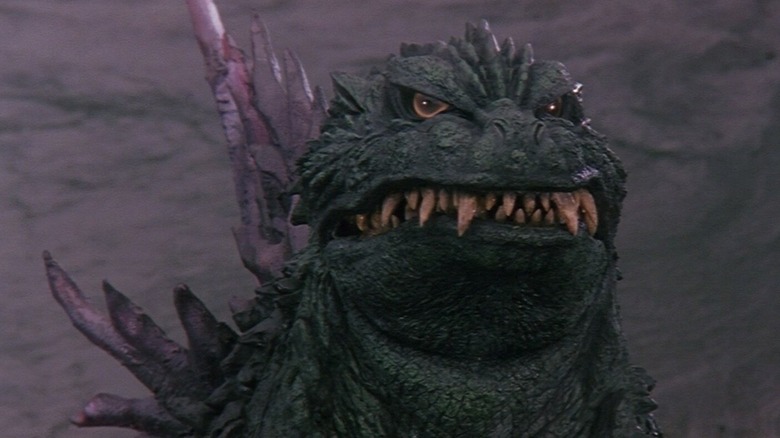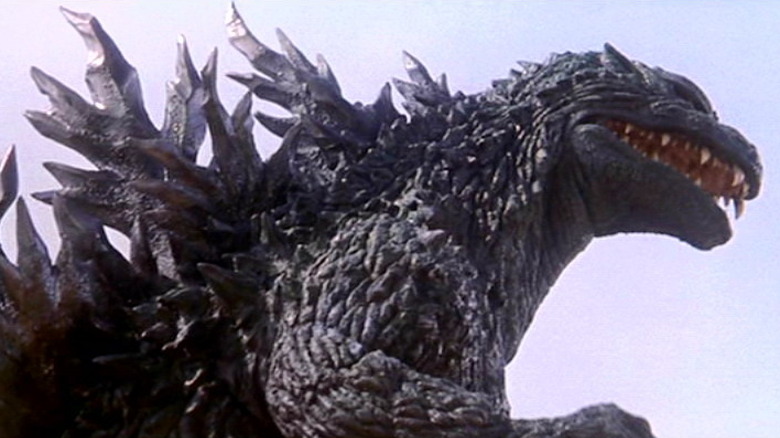An Oxygen Tube Mishap Put One Godzilla Actor In A Life-Threatening Situation
It takes a lot of skill, physical endurance, and a certain je-ne-sais-quoi to play Godzilla. The late great Haruo Nakajima — who played Godzilla in 12 of the Showa-era films from the original "Godzilla" through "Godzilla vs. Gigan" in 1974 — revealed in an interview with the Hollywood Reporter in 2017 that he modeled his movements on bears. He seemingly wanted Godzilla to look like he weighed a lot and lumbered appropriately. Nakajima was no doubt aided by the fact that the Godzilla suit weighed quite a lot and was difficult to move in. It was Nakajima who developed the signature "put up your dukes" movement for Godzilla, a gesture that gave the giant radioactive gorilla-whale a lot of personality.
When Nakajima retired from playing Godzilla, a few different actors took turns in the role until the making of 1984's "Return of Godzilla" (released as "Godzilla 1985" in the United States). In that film Kenpachiro Satsuma took over the role, having gained experience playing monsters like Hedorah and Gigan. Satsuma played Godzilla throughout the Heisei era, ending with "Godzilla vs. Destroyah" in 1995. When the Godzilla series rebooted in 1999 with "Godzilla 2000," longtime tokusatsu actor and suit performer Tsutomu Kitagawa took over the monster role. Kitagawa played Godzilla throughout the Millennium era, ending his tenure in 2004 with the release of "Godzilla: Final Wars."
Each of these performers brought a subtle, unique, monstrous body language to the role that's hard to describe, but definitely recognizable. More than anything, one has to admire the enormous physical strain it took to wear the Godzilla suits. Indeed, in the same Hollywood Reporter interview mentioned above, Kitagawa recalled a time when he had to be submerged underwater in the Godzilla suit, and how his breathing tube came detached, nearly drowning him.
Drowning Godzilla
Godzilla is, of course, an amphibious creature, so each of the Godzilla actors had experience splashing around in specialized tanks built in the Toho studios. This was especially fraught, given that the Godzilla suits were hard to breathe in as is. Getting an actor underwater requires careful planning. Sadly, that planning often went awry. Kitagawa recalls working on one of the Millennium-era Godzilla movies, and a terrifying moment when his breathing apparatus was damaged. He was to be pushed underwater by a crane. He said:
"You can't breathe well inside the suit, so an oxygen tube is attached. [...] But it's removed during takes. Sometimes I started suffocating and had to stop filming. [For an underwater scene] I was standing by. The oxygen tube was attached the crane started to move. As I went down the tube came off. [...] I screamed, 'Stop! I can't breathe!' But they kept pushing me into the water. Because of the danger, those shots were stopped. I never want to do that again."
Satsuma joined in to say "We risked our lives in that water."
As the Godzilla films have progressed over the last 70 years, the suits have improved with each iteration. Nakajima said that he "went to the special effects studio every day. [...] I'd suggest a slit here, a slit there." Kitagawa went so far as to design suits that allowed for more flexibility. "I prepared data for the suit makers, just like an F-1 racer. [...] The suit for 'Godzilla: Final Wars' was the most flexible ever."
Since "Final Wars," however, Godzilla has been visualized by CGI and motion-capture techniques, forgoing on-set suits. The effects in newer Godzilla films are excellent, but one might argue that something has been lost. At the very least, the risks of drowning are gone.

